Neon tetras are popular freshwater fish that are perfect for beginner hobbyists with little to no experience. They are small, peaceful, and not to mention beautiful fish, which clarifies their vast popularity.
Something people struggle with, however, is finding the right tank mates for them, that will add value to you and your neon tetra, oh, and not end up eating them!
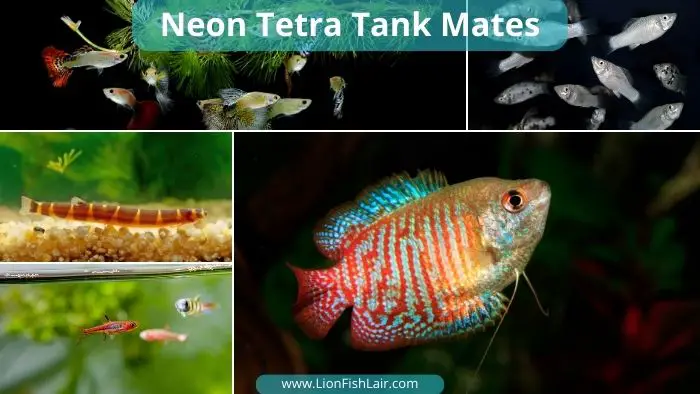
Fortunately, there are some great options, and thanks to our experience with neon tetras, we can provide you with honest and realistic feedback on each of them and their relationship with neon tetras.
Tank Mates for Neon Tetras - What to Look out for
It is all well and good checking out our list and selecting one or two fish that you like the look and sound of. But this is just our opinion, and you might despise the fish featured on this list.
So, if you would rather choose a fish that we haven't recommended here, make sure you pick one that fits the following criteria:
- Small in size, between 3 to 4 inches (8 to 10 cm) maximum.
- Peaceful by nature.
- Community-friendly fish.
- Tropical fish that require a temperature between 72°-76°F (22°-24°C).
- Fish that can healthily live in a 10-gallon (38 liters) aquarium or more.
The reason why we do not advise you to have a tank mate larger than 4 inches in length is because of how tiny neon tetras are.
Due to their small size, they are vulnerable to being bullied or even eaten, not to mention that they will likely go hungry too as larger fish typically get first dibs when feeding time comes around.
Neon Tetra Compatibe Tank Mates - Graphical Summary
If you do not wish to read our detailed list due to time issues, or because you prefer to intake information visually, we have created a graphic to summarize this entire article. You can also download a PDF version of the infographic further down the page. Check it out below:
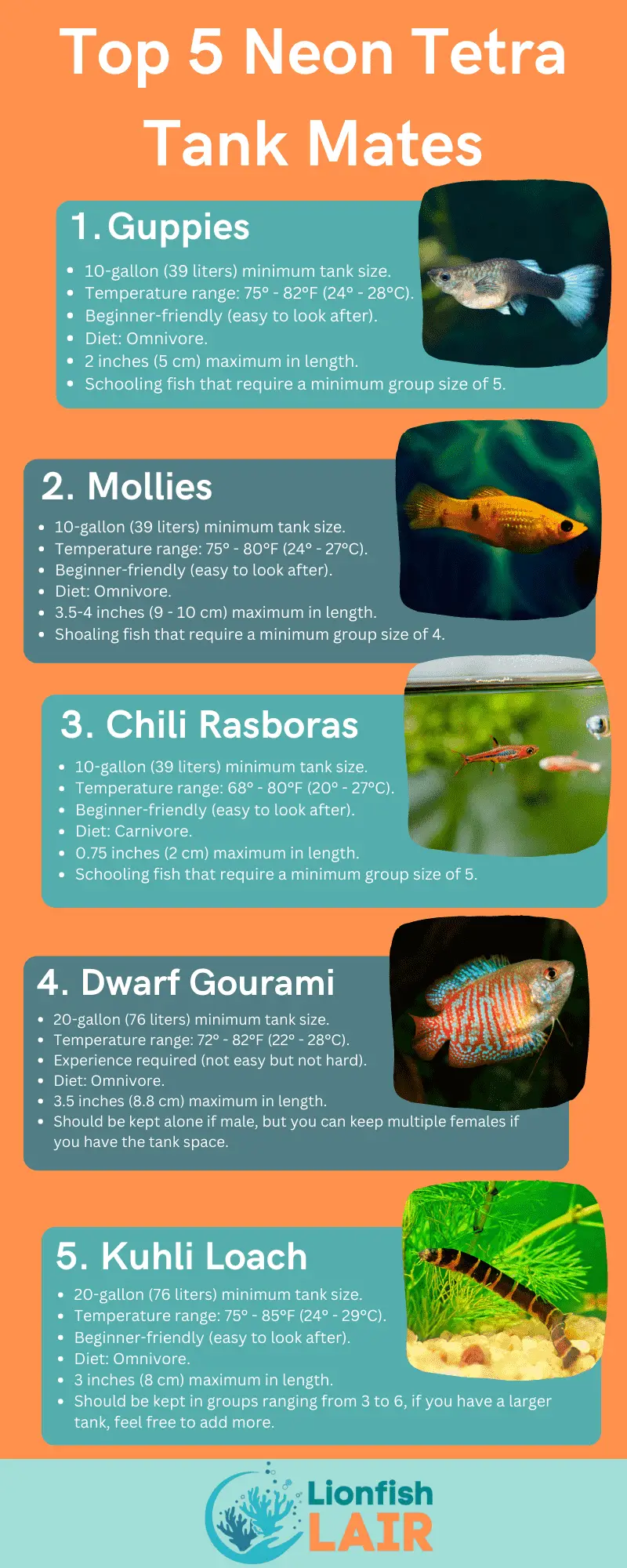
Top 5 Neon Tetra Tank Mates
Now that we know what you need to be looking for when it comes to tank mates for your neon tetra, let's take a look at our awesome suggestions!
1. Guppies (Poecilia reticulata)
Guppies might be the only fish on this list that are equally as popular as neon tetras themselves. They are beautiful fish and peaceful by nature, their unique patterns and colorations are a sight to behold too, not to mention they have one of the coolest-looking tails out of any fish featured on this list.
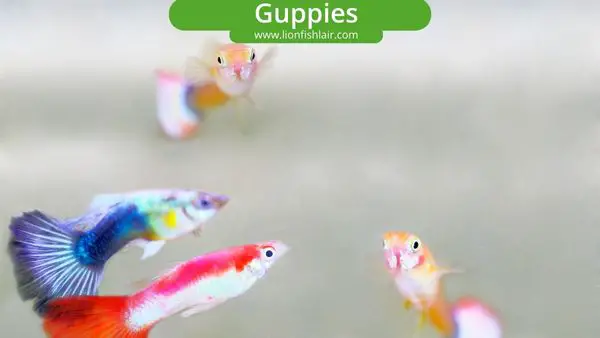
- 10-gallon (39 liters) minimum tank size.
- Temperature range: 75° - 82°F (24° - 28°C).
- Beginner-friendly (easy to look after).
- Diet: Omnivore.
- 2 inches (5 cm) maximum in length.
- Schooling fish that require a minimum group size of 5.
They are extremely active fish that enjoy being in schools of 5 or more, guppies are not territorial, nor are they aggressive fish. Guppies will spend most of their day exploring your aquarium as a school.
They should be kept in groups of all males or all females. However, if you want to mix them up for breeding purposes or variety, you should keep two to three females per male. Be careful, as guppies tend to produce fry like wildfire, and if you're not careful, your guppies will eat their babies!
2. Mollies (Poecilia sphenops)
Molly fish accompany neon tetras very well, they are certainly on the large side of possible neon tetra tank mates, however, they are an extremely compatible pairing.
There are tons of different types of mollies that you can choose from, ranging in coloration and patterns, with a common color being bright orange/yellow.
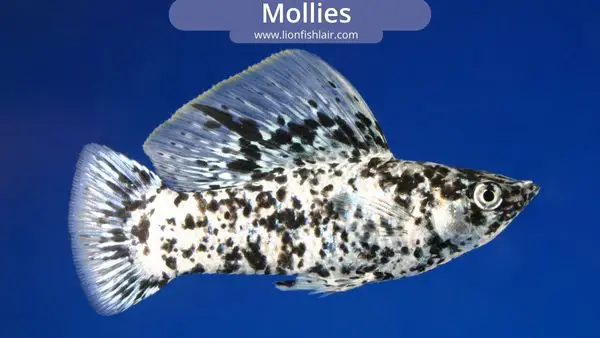
- 10-gallon (39 liters) minimum tank size.
- Temperature range: 75° - 80°F (24° - 27°C).
- Beginner-friendly (easy to look after).
- Diet: Omnivore.
- 3.5-4 inches (9 - 10 cm) maximum in length.
- Shoaling fish that require a minimum group size of 4.
Mollies tend to prefer residing in shoals, feeling more comfortable being around their own. Their minimum shoal size is 4 mollies, but we would recommend as many as your tank size will allow you.
You should typically keep just 1 male to 3 female mollies as a ratio, this is due to them being active breeders, so, keeping just one male to 3 or more females should share the male's attention equally.
Not only are mollies incredibly active fish, but they are also hardy, making them far less susceptible to diseases than most other freshwater fish. Their peaceful nature makes them brilliant community fish and tank mates for neon tetras.
3. Chili Rasboras (Boraras brigittae)
These guys are truly mesmerizing fish, suitable for almost any freshwater environment! Perhaps the most unique-looking fish on this list, the chili rasbora sports a tiny, slim body, with an almost neon-red coloration covered in different-sized black and dark blue markings.
If you are a freshwater fishkeeper and you have never considered owning one of these fish, you must reconsider now!
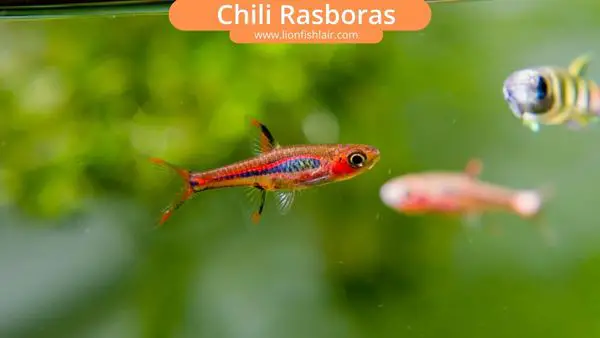
- 10-gallon (39 liters) minimum tank size.
- Temperature range: 68° - 80°F (20° - 27°C).
- Beginner-friendly (easy to look after).
- Diet: Carnivore.
- 0.75 inches (2 cm) maximum in length.
- Schooling fish that require a minimum group size of 5.
Chili rasboras typically spend most of their time residing in schools at the top of their fish tank, keeping themselves to themselves. They are well coordinated when swimming in a school, which is truly a sight to behold.
Funnily enough, they are smaller than neon tetras, which cannot be said about the other fish on this list, so, you will need to ensure that they are eating enough and aren't getting their food stolen.
Another brilliant characteristic is their hardiness, they are truly hardy fish that will likely not pick up disease or illnesses even if they tried to. You shouldn't keep them in schools of less than 5, however, to unlock their full potential, we would suggest keeping them in a school of 10. Remember, they are tiny fish!
4. Dwarf Gourami (Trichogaster lalius)
Who doesn't love dwarf gouramis? And, if you don't know anything about them, you are certainly in for a treat! They are considered to be laterally compressed fish, meaning that their body is super thin and almost disc-shaped.
These gouramis have large dorsal and anal thins and showcase a truly magical appearance, sporting a silver/light blue and orange striped body, with two thin and long feelers located underneath their heads.
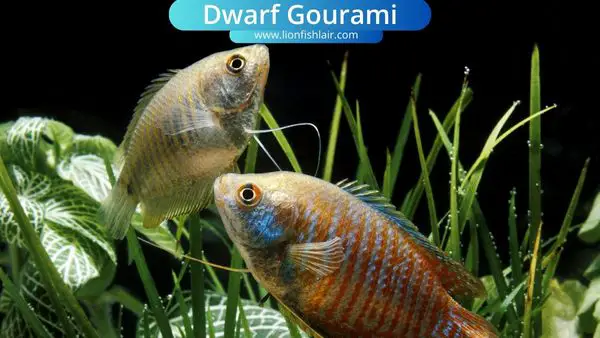
- 20-gallon (76 liters) minimum tank size.
- Temperature range: 72° - 82°F (22° - 28°C).
- Experience required (not easy but not hard to look after).
- Diet: Omnivore.
- 3.5 inches (8.8 cm) maximum in length.
- Should be kept alone if male, but you can keep multiple females if you have the tank space.
Dwarf gouramis, unlike the rest of the fish on this list, are shy and docile, that enjoy a heavily-planted tank full of hiding spots for them to reside whenever they feel stressed.
Their rather unique feelers are used to gauge what's around them through touch. Despite being shy, they are curious fish that will always approach new things (with caution).
When it comes to keeping them in groups, you will only be able to achieve this by keeping multiple females together. The males are incredibly hostile towards each other, with nearly always leads to them fighting, resulting in incredibly stressed-out and unhealthy fish.
These guys are beautiful, must-see freshwater fish and make for brilliant neon tetra tank additions, not to mention they are hardy too.
5. Kuhli Loach (Pangio kuhlii)
We have certainly saved the weirdest and most unusual-looking fish until last. The kuhli loach is an incredibly unique fish, taking up the appearance of an eel and also a snake, with a long thin body, displaying a black/brown and orange stripy coloration.
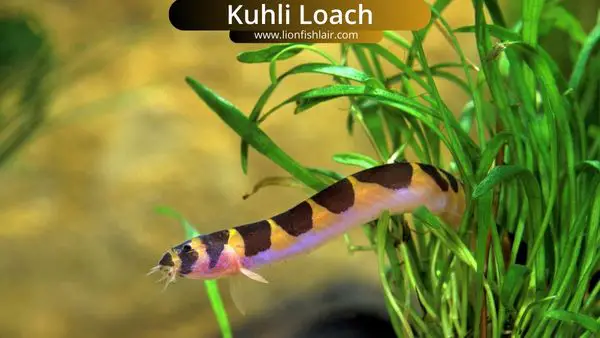
- 20-gallon (76 liters) minimum tank size.
- Temperature range: 75° - 85°F (24° - 29°C).
- Beginner-friendly (easy to look after).
- Diet: Omnivore.
- 3 inches (8 cm) maximum in length.
- Should be kept in groups ranging from 3 to 6, if you have a larger tank, feel free to add more.
They are incredibly shy fish, but super peaceful, keeping themselves to themselves and typically hiding away at the bottom of the tank in dark, shaded areas. Once the lights are out they will come alive, searching for uneaten food, which is fantastic for maintaining a clean aquarium without having to constantly clean it yourself.
Due to their relaxed behavior, males and females can live with each other in harmony, without the risk of aggressiveness or in-house fighting. Despite not always schooling together, they get along with their own very well, often occupying different areas of the fish tank, in search of food.
These guys are seriously hardy fish too, giving you one less thing to worry about.
Here's Your Neon Tetra Tank Mates Free Downloadable PDF
It can sometimes be hard to absorb all the information that you read in an article, which is why we wanted to create something for you to download or print out to use as a reference for our list of neon tetra tank mates.
So, with the free downloadable PDF below, you can check out all of the tank mates that appear on our list and their requirements with the click of a button!
Tank Mates to Avoid for Your Neon Tetra
Neon tetras are tiny little guys with big hearts! So, they need to be housed with similar fish - they do not cope well at all with being bullied. Stress in a fish can lead to all sorts of health problems, which is never good.
Not to mention, if your neon tetras are stressed out, they will typically lose their unique and beautiful bright coloration! Fish that are too large will simply eat your tetras, so, best to avoid fish over 4.5 to 5 inches (11 - 13 cm) in length.
There are some beliefs that neon tetra and angelfish cannot live together, well, this isn't exactly true, but you should check out our specific article to learn more.
Also, despite what many people say, neon tetras and goldfish cannot live together for an abundance of reasons. If you want to learn more about why goldfish and neon tetra can't live together, you should take a look at our article dedicated to this.
Final Thoughts
Thank you so much for taking the time to read our article guys, there is obviously an abundance of brilliant options when it comes to tank mates for neon tetras, and the ones that feature on this list are simply from our personal experiences.
Just make sure that you remember the criteria when choosing your own neon tetra tank mates and you will do just fine. Good luck!
